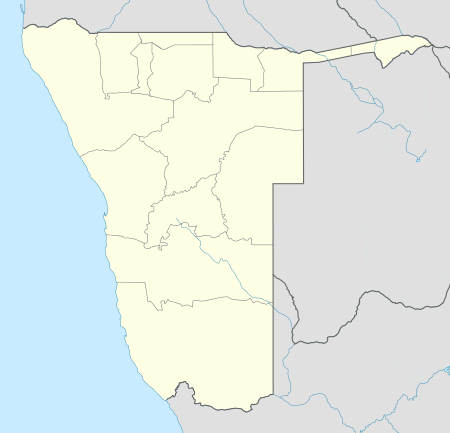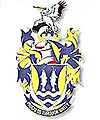Henties Bay
| Henties Bay Afrikaans: Hentiesbaai German: Hentiesbucht | ||
|---|---|---|
| City | ||
|
| ||
| ||
 Henties Bay | ||
| Coordinates: 22°07′06″S 14°16′57″E / 22.1184°S 14.2824°E | ||
| Country |
| |
| Region | Erongo Region | |
| Constituency | Arandis Constituency | |
| Established | 1929 | |
| Government | ||
| • Mayor | Aila Haufiku | |
| Population (2015)[1] | ||
| • Total |
8,000–10,000 (seasonal) | |
| Climate | BWk | |
Henties Bay (English, literally: Henty's Bay. Afrikaans: Hentiesbaai, German: Hentiesbucht) is a coastal city[2] in the Erongo Region of western Namibia. It is located 70 km north of Swakopmund and is an important holiday settlement. 70 kilometres to the north of the town is the seal colony of Cape Cross. The town has about 8,000 inhabitants (10,000 during the holiday season)[1] and owns 121 square kilometres (47 sq mi) of land.[3] The mayor of Henties Bay is Aila Haufiku.[4]
History
Bartolomeu Dias sailed along the Atlantic coast in 1488. Near the area of today's Henties Bay he discovered such an abundance of fish that he named this coastline Praai das Sadhinas, Coast of Fish. The fresh water source was first discovered by Schutztruppe soldiers in 1886. In 1920, a minerals prospector stayed overnight. After tasting the water he was said to be healed from an affliction.[5]
The namesake of the town is major Hendrik "Henty" Stefanus van der Merwe who discovered the place in 1929 while looking for water. He had been hunting a rhinoceros in the arid hinterland of the Namibian coast near the Brandberg in order to collect a reward from a museum in Pennsylvania that was in search of a rhino skeleton. After shooting the rhino and scraping meat from the bones, water resources of the expedition diminished and forced the party to load the decomposing carcass and search for water.[6][7]
They chose to head into the direction of the Atlantic coast and reached it close to Cape Cross. From there van der Merwe and his fellows searched southwards for the mouth of Omaruru River. A few miles south of the mouth they discovered a deep sand valley with reed grass growing in it, advertising the presence of fresh water. Van der Merwe liked the place and after delivering the bones and collecting his reward, returned the following Christmas to build a wooden hut in the riverbed. The place became known as Henty se baai (Henty's Bay) and developed into a holiday hideout,[6] mainly because of the abundance of fish at this spot.[5]
In 1951 the South–West Africa Administration mandated to South Africa, proclaimed erven in the Omaruru riverbed that were available for rent, but the erection of permanent structures was not allowed. The first shop was established during that time. A light house was erected to guide ships along the dangerous Namibian coast. In the 1960s mining holes were dug after diamonds had been found in the area on a few occasions. A few years later mining was abandoned due to lack of success. In 1966 it was decided that the riverbed must not be settled in, and property north and south of it was sold. A hotel was built one year later, and the town began to develop.[7]
Environment and tourism
The town is predominantly a tourist destination for anglers and 4x4 enthusiasts. Its property market has expanded significantly since the late 1990s, particularly for upmarket holiday accommodation.[5]
Henties Bay is situated in the National West Coast Recreation Area but there are few restrictions, particularly for driving off-road on the beach and across the plains. This lures tourists into the area but puts a burden on the sensitive environment. Specifically in danger are the lichen fields which take decades to recover from tracks cut through them, and the Damara Tern which is endemic to the Skeleton Coast and threatened by habitat loss.[8]
Politics
Henties Bay is home to the Civic Association of Henties Bay, a local political party which contests local elections. In the 2010 local election, the party received the most votes (approximately 44%), while SWAPO finished in 2nd place with approximately 37%. The Rally for Democracy and Progress, which was the party of opposition in the National Assembly following the 2009 general election, also contested the election and received 4%.[9] From 2004-10, the local authority of Henties Bay included 3 members of the Civic Association, 3 SWAPO members and 1 member of the UDF.[10]
Town council corruption affair
In November 2009, three town councillors, the town human resources manager and the town CEO were arrested on corruption charges stemming from the hiring of friends of the officials as general labourers in 2007.[11]
References
- ↑ 1.0 1.1 Hofmann, Eberhard (2 January 2015). "Henties Bay im Aufwind" [Henties Bay on the rise]. Allgemeine Zeitung (in German). p. 1.
- ↑ "Local Authorities". Association of Local Authorities in Namibia (ALAN). Retrieved 1 October 2012.
- ↑ "ELECTIONS 2010: Erongo regional profile". New Era. 16 November 2010.
- ↑ "Machtwechsel in Henties Bay" [=Change of Power in Henties Bay]. Allgemeine Zeitung (in German). 14 December 2012.
- ↑ 5.0 5.1 5.2 "Henties Bay Namibia". Namibia 1on1. Retrieved 24 December 2010.
- ↑ 6.0 6.1 "Dors en 'half verrotte renosterkarkas lei tot Hentiesbaai se ontstaan" [Thirst and a decomposing rhinoceros carcass lead to the foundation of Henties Bay]. Die Republikein (in Afrikaans). Reprint of an interview with Henty van der Merwe in the magazine 'Die Brandwag' on 29 April 1977, published as 'Gondwana History#20' on 24 December 2010. Check date values in:
|date=(help) - ↑ 7.0 7.1 "History Henties Bay Namibia". Henties Bay Tourism. Retrieved 24 December 2010.
- ↑ "Conservation in Henties Bay". Henties Bay Tourism. Retrieved 24 December 2010.
- ↑ Swapo Dominates Local Polls The Namibian, 1 December 2010
- ↑ New mayor to heal rift in Henties community The Namibian, 4 June 2004
- ↑ Hartmann, Adam (6 November 2009). "Five Henties Council officials arrested". The Namibian.
